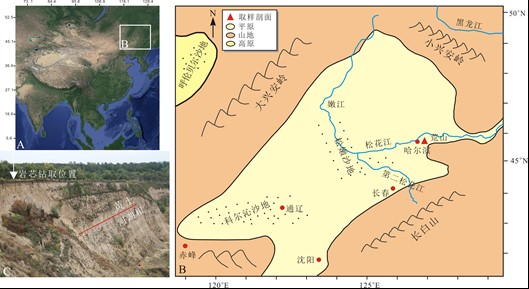博文
刘硕,迟云平等——中更新世以来松嫩平原夏季风演化:来自哈尔滨黄土的磁化率、地球化学和总有机碳记录
||
中更新世以来松嫩平原夏季风演化:来自哈尔滨黄土的磁化率、地球化学和总有机碳记录
刘 硕1 迟云平1,2 郝冬梅1 谢远云1,2 康春国3 吴 鹏1
(1. 哈尔滨师范大学地理科学学院 哈尔滨 150025;2. 哈尔滨师范大学寒区地理环境监测与空间信息服务重点实验室
哈尔滨 150025;3. 哈尔滨学院地理系 哈尔滨 150086)
摘 要 哈尔滨黄土位于松嫩平原东北部,处于欧亚大陆中纬度干旱—半干旱地带的东部边缘,是季风和非季风区的过渡地带,对季风气候的变化非常敏感。然而,由于沉积档案露头的缺乏,使得该地区的气候变化研究极为薄弱。为此,我们对哈尔滨黄土进行了磁化率、总有机碳(TOC)和地球化学测试,并结合小波分析,对松嫩平原中更新世以来的夏季风演变及其控制机制进行研究。结果表明,中更新世以来松嫩平原的夏季风演化分为两个阶段:1)460~180 ka时期,哈尔滨黄土较低的化学风化程度和TOC值指示了弱的夏季风强度;另外,在此时期还存在3个次一级的夏季风的微弱增强,叠加在夏季风强度偏弱这一大趋势之上。2)180 ka~至今,哈尔滨黄土—古土壤序列的磁化率、化学风化程度和TOC值呈现出逐渐增大的趋势,表明东亚夏季风强度逐渐增强。通过哈尔滨黄土与邻区赤峰黄土和黄土高原洛川黄土的磁化率和粒度综合对比分析,表明松嫩平原首先响应间冰期夏季风主导的温度升高及降水增加带来的气候变化,但这种响应的持续时间偏短;哈尔滨黄土记录了360~340 ka和280~250 ka两次显著的夏季风减弱的气候现象,这是全球气候和区域环境变化综合作用的结果。小波分析结果表明,哈尔滨黄土—古土壤序列磁化率小波变换的主导周期为98 ka(100 ka),结合海平面温度、全球CO2浓度、60°N太阳辐射量、深海氧同位素综合对比分析,表明松嫩平原夏季风演化主要受全球冰量驱动;36 ka和44 ka(40 ka)倾角周期以及最低振荡29 ka周期的出现,表明倾角驱动的低纬太阳辐射变化对松嫩平原夏季风起到微弱调控作用,而岁差驱动的低纬太阳辐射变化对松嫩平原影响较小。
关键词 东亚夏季风 哈尔滨黄土 松嫩平原 地球化学组成 磁化率
Evolution of summer monsoon in Songnen Plain since Middle Pleistocene: Magnetic susceptibility, geochemistry and total organic carbon records
from Harbin loess
Abstract:Harbin loess is located in the northeast of Songnen Plain, on the eastern edge of arid and semi-arid zone in the middle latitude of Eurasia. It is a transition zone between monsoon and non-monsoon regions and is very sensitive to the change of monsoon climate. However, due to the lack of outcrops of sedimentary archives, the study of climate change in this area is weak. Therefore, we measured the magnetic susceptibility, total organic carbon (TOC) and geochemistry element of the Harbin loess, and combined with wavelet analysis, studied the evolution and control mechanism of summer monsoon in the Songnen Plain since Middle Pleistocene. The results show that the evolution of summer monsoon in the Songnen Plain can be divided into two stages since the Middle Pleistocene: 1) From 460 ka to 180 ka, the lower chemical weathering degree and TOC values of the Harbin loess indicate the weak intensity of summer monsoon. In addition, there were three sub-orders of the summer monsoon during this period, superimposed on the general trend of weak summer monsoon. 2) From 180 ka to now, the magnetic susceptibility, chemical weathering degree and TOC values of the Harbin loess-paleosol sequence show a gradually increasing trend, indicating that the intensity of East Asian summer monsoon is gradually enhanced. Through the comprehensive comparative analysis of the magnetic susceptibility and grain size of the Harbin loess, the Chifeng loess and Luochuan Loess in the Chinese Loess Plateau, it shows that the Songnen Plain first responds to the climate change caused by the temperature rise and precipitation increase dominated by the interglacial summer monsoon, but the duration of this response is relatively short; The loess of Harbin recorded two significant climatic phenomena of summer monsoon weakening from 300 ka to 340 ka and 280 ka to 250 ka, which were the result of the comprehensive action of global climate and regional environmental change. The results of wavelet analysis show that the dominant period of wavelet transform of susceptibility of the Harbin loess-paleosol sequence is 98 ka (100 ka). Combined with the comprehensive comparative analysis of sea-level temperature, global CO2 concentration, 60°N solar radiation and marine isotope stages, it shows that the evolution of summer monsoon in the Songnen Plain is mainly driven by global ice volume. The occurrence of dip periods of 36 ka and 44 ka (40 ka) and the occurrence of the lowest oscillation period of 29 ka indicate that the dip driven variation of low latitude solar radiation has a weak regulation effect on the summer monsoon in Songnen Plain, while the precession driven variation of low latitude solar radiation has little effect on the summer monsoon in Songnen Plain.
Keywords East Asian summer monsoon, Harbin loess, Songnen Plain, Geochemical composition, Magnetic susceptibility
东亚夏季风(East Asian Summer Monsoon,EASM)作为亚洲夏季风的重要组成部分(Wang et al., 2005),是形成夏季东亚气候的主要环流和降水系统(丁一汇等,2018)。东亚夏季风强度的变化是导致中国东部地表系统变化和人类社会环境变化的基本因素之一(Wang, 2009)。因此,对东亚夏季风区域性变化及其驱动机制的研究将有助于增进对气候演化的理解,提高预测区域和全球气候长期趋势的能力(Liu et al., 2015)。
东亚季风的强弱变化是对地表所接受的太阳辐射变化及其季节性旋回的响应(安芷生等, 1991a),强烈的冬季风和夏季风分别主导了冰期和间冰期(Wang et al., 1999; Wang et al., 2003; Wang et al., 2005)。国内外学者常用黄土—古土壤(An et al., 1991)、深海沉积物(Hu et al., 2012)、冰芯(Ding et al., 1992)、洞穴石笋(Porter et al., 1992)、湖泊沉积物(Sun et al., 2018)等作为季风演化的载体进行相关研究。其中黄土—古土壤序列作为古气候变化研究的良好载体,很好地记录了这种冰期—间冰期气候的旋回变化(An et al., 1991; Dodonov and Baiguzina, 1995; Bronger et al., 1998; An, 2000; Liu et al., 2016; Wang et al., 2018),对于重建东亚古季风演化具有非常重要的研究价值(刘东生,1985;安芷生等,1991b)。在对不同纬度地区的季风研究中,出现了不同的季风驱动机制差异。在中国南方洞穴石笋δ18O出现了典型的20 ka周期的岁差驱动(Partridge et al., 1997; Wang et al., 2008);在北方黄土高原黄土—古土壤序列上则以100 ka周期为主的全球冰量驱动(丁仲礼等, 1995)。这种不同的轨道尺度变率特征,可能与季风敏感性差异有关(安芷生等, 2015)。目前对东亚季风的研究多集中在我国西北地区,而东北较少,仅有的研究存在于东北赤峰地区(Zeng et al., 2017)。欧亚黄土带最东部松嫩平原黄土古季风驱动机制的研究仍然是一片空白,中国东北地区黄土究竟是受高纬冰量强迫还是低纬岁差强迫尚不清楚。
中国东北位于欧亚大陆中纬度地区,受亚洲季风环流系统与极地气候系统相互作用的影响(Sun et al., 2018),对季风气候的变化尤其敏感(Shen, 2013),使其成为较好的夏季风研究区域。国内外学者运用了磁化率、总有机碳含量、化学风化指数、Rb/Sr比值作为夏季风的替代性指标重建了东亚夏季风的演化历史(安芷生等,1991a,1991b;An et al., 1991, 2001; 陈骏等, 1998; Ding et al., 2001; Johnson et al., 2006; Yang and Ding, 2008; Zhang et al., 2008; Liu et al., 2015),并取得了良好的效果。因此本文以哈尔滨黄土—古土壤序列为研究对象,通过对其进行磁化率、元素地球化学及总有机碳(TOC)分析,探讨松嫩平原黄土堆积对夏季风的响应状况。本研究对于认识我国东北地区黄土沉积与环境变化提供区域资料,为理解东亚季风及其区域响应提供参考和借鉴。

图1 中国东北地区的位置(a),松嫩平原地貌及荒山剖面位置(b),荒山部分露头照片(c)
白色箭头为岩芯钻取位置,红色界线区分上部黄土—古土壤序列与下部河湖相地层
Fig. 1 The location of Northeast China (a), the geomorphology of Songnen plain and the profile of barren mountains (b), the outcrop photo of Huangshan section (c)
https://blog.sciencenet.cn/blog-400480-1295743.html
上一篇:张宇昕,亚夏尔·亚力坤等——新疆温泉南部哈尔达坂石英二长岩年代学、地球化学及构造意义
下一篇:周慧,黄理力等——塔里木盆地北部跃南断裂带的形成演化